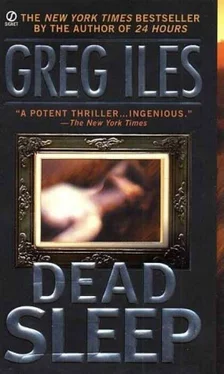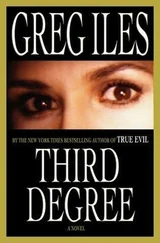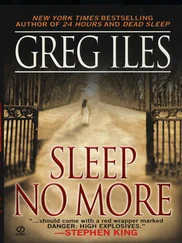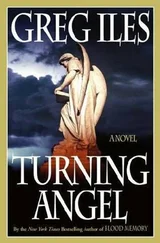“Wait here,” says Sims.
The door shuts, then locks from the outside. Do they think I’m going to prowl the halls, looking for something to steal? If someone doesn’t show in the next two minutes I might just sack out on the table. The last thing I want to do is sit down; my behind feels like a massive hematoma. Despite my exhaustion, I’m still nervy from the fire and the knowledge that Wingate is dead. The investigation will be severely handicapped without him. One thing is sure, though. It’s not going to be like last year. Nobody’s shutting me out this time.
The doorknob clicks. Then the door opens and two men walk in. The first is Daniel Baxter, looking scarcely changed from thirteen months ago when I first met him. He’s dark-haired and compact, about five-ten, and corded with muscle. His eyes are brown and compassionate but steady as gunsights. The man behind him is taller – over six feet -and at least ten years older, with silver hair, an expensive suit, and a bluff Yalie look. But his grayish-blue eyes, hooded by flesh, suggest a sinister George Plimpton. Baxter doesn’t move to shake my hand, and he speaks as he takes his seat.
“Ms. Glass, this is Doctor Arthur Lenz. He’s a forensic psychiatrist who consults for the Bureau.”
Lenz extends his hand, but I only nod in return. Shaking hands with men is always awkward for me, so I don’t do it. There’s no way to equalize the size difference, and I don’t like them to feel they have an edge. The men I know well, I hug. The rest can make do.
“Please sit down,” says Baxter.
“No, thanks.”
“I suppose you have an explanation for missing the plane I booked for you?”
“Well-”
“Before you go any further, let me advise you that Christopher Wingate has been under Bureau surveillance since you called me from the airplane.”
I wasn’t sure whether I was going to admit being at the fire. Now there’s no way to deny it. “You had people outside his gallery?”
Baxter nods, his face coloring with anger. “We’ve got some nice shots of you entering the building about forty minutes before it went up.” He opens a file labeled “NOKIDS” and slides a photo across the table. There I am, in low-res digital splendor.
“I knew Wingate probably had information about my sister.”
“Did he?”
“Yes and no.”
Baxter’s anger boils over at last. “What the hell did you think you were going to accomplish in there?”
“I did accomplish something in there! And it’s a good thing I did, because he would have been dead by the time you guys decided to question him.”
This sets them back a little.
“And if you had people outside the gallery,” I push on, “why didn’t they bust in there and try to save us?”
“We had one agent at the scene, Ms. Glass, doing surveillance from his car. The fire started on the first floor, and it was explosive in nature. An incendiary device made of gasoline and liquid soap.”
“Homemade napalm.” I know it well from the “little wars” that don’t make the evening news.
“Yes. The sprinkler system was disabled prior to the device being detonated, the fire alarm as well. We’ve since determined that the fire escape ladders were also wired in the up position. All inoperative.”
“You think you’re telling me something? I had to jump to save myself. Your guy couldn’t do anything to help?”
“Our guy did do something. He died there.”
A wave of heat tells me my face is red.
Baxter’s eyes are merciless. “Special Agent Fred Coates, twenty-eight years old, married with three kids. When the bomb went off, he called the fire department. He got out of his car and shot pictures of the building and the first people on the scene, in case the perp stuck around. Then he got back into his car and called the New York field office on his cell phone. He was talking to his Special Agent in Charge when somebody reached through the window and slit his throat. The SAC heard him coughing up blood for twenty seconds. Then nothing. The killer stole his credentials and camera. He missed one flash memory card that had fallen between the console and Agent Coates’s seat. That’s where we got the shot of you. We lost his pictures of the crowd.”
“Jesus. I’m sorry.”
Baxter spears me with an accusing look. “You think that helps anything? I told you to come straight here.”
“Don’t try to put this on me! I didn’t put that guy there, okay? You did. Whoever killed him would have set that fire whether I was there or not. And I do have pictures of the crowd.”
Both men lean forward, their mouths open.
“Where?” asks Dr. Lenz.
“We’ll talk about that in a minute. I want to clarify something right up front. This isn’t going to be a one-way conversation.”
“Do you realize how important every minute is?” Baxter asks. “By withholding that film-”
“My sister’s been missing for over a year, okay? I think she can wait another twenty minutes.”
“You don’t have all the facts.”
“And that’s exactly what I want.”
Baxter shows Lenz his exasperation.
“Could someone have killed Coates for his wallet and camera?” I ask. “Could his murder be unrelated to the fire?”
“Why leave the cell phone behind?” Baxter counters. “And the car? His keys were found in the ignition.”
“What are the odds that a garden-variety arsonist would murder someone watching a fire?”
“Million to one against. Ms. Glass, that firebomb was planted to do exactly what it did. Kill Wingate and destroy his records. You’re lucky you didn’t go up with the rest.”
“It was Wingate who almost killed me. He could have saved himself, but he tried to save the stupid painting, and like a fool I tried to save him.”
“What painting?” asks Lenz.
“Sleeping Woman Number Twenty. It was the only one of the series he had in the place, and he killed himself trying to save it.”
“I wonder why,” Lenz says softly. “Surely it would have been insured.”
“The insurance wouldn’t have been enough.”
“Why not?”
“When I told Wingate I was going to the FBI, that the women in the pictures were almost certainly the victims from New Orleans, he was ecstatic. He said the new canvas would probably sell for double the standing bid on it, and that was one point five million pounds sterling.”
“Did he mention the bidder’s name?”
“Takagi.”
“What did the painting look like?” Lenz asks. “Like the ones you saw in Hong Kong?”
“Yes and no. I don’t know anything about art, but this one was more realistic than the ones I saw. Almost photographically realistic.”
“The woman appeared to be dead?”
“Absolutely.”
Baxter reaches into the file, removes a photograph, and pushes it across the table at me. It’s a head shot of a young dark-haired woman, a candid shot, probably taken by a family member. It’s well off horizontal, which makes me think it was taken by a child. But that’s not what sends a shiver through me.
“That’s her. Damn it. Who is she?”
“Last known victim,” Baxter replies.
“How long ago was she taken?”
“Four and a half weeks.”
“What was the interval between her and the one before her?”
“Six weeks.”
“And before that?”
“Fifty-four days. Seven and a half weeks.”
This decreasing time span bears out my reading, as well. One theory says that as serial offenders get a taste for their work, their confidence grows, and they try to fulfill their fantasies more and more frequently. Another speculates that they begin to “decompensate,” that the neuroses driving them begin to fracture their minds, pushing them toward capture or even death, and the path they choose is accelerated murder.
Читать дальше
Конец ознакомительного отрывка
Купить книгу












